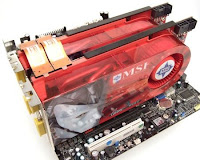well now that that is out of the way...
I also have a desktop... if there are more slots for the Graphics cards, and I put in a new card, will the computer use both the old and new?
For crossfire two GPU's that have the first two digits can be crossfired, like HD 7750 and HD 7770. You can't pair an HD 5850 with an HD 7850.
For SLI you can't have two GPU's unless they are the same card, you can have different brands/vram but in some occasions there are two cards with different names but they are the same card overall. Like an GTX 9800+ and GTS 250 you can SLI, same card, different name.
But both cards will downclock themselves so it matches the weakest card out of the two. Same goes for VRAM, if one card is 1GB and one card is 512mb, overall you can only use 512mb.
Someone correct me if I'm wrong.
and how does one bridge them?
Most cards that you buy that are SLI/Crossfire capable come with a small cable that looks like this;

Which you can put on the cards like this;
